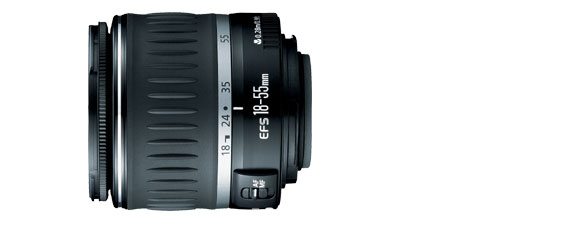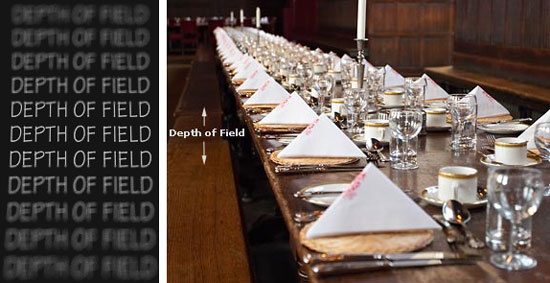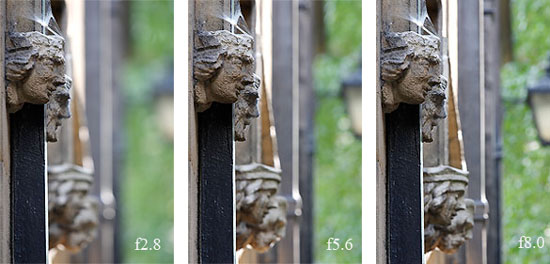Digital Photography from 20,000 Feet
by Wesley Fink on September 25, 2006 12:05 AM EST- Posted in
- Digital Camera
F Stop: The Speed of the Lens
Most buyers today are used to the idea of zoom lenses, and they aren't even aware of how many compromises the common "kit" zoom lens forces on them. The biggest compromise by far is lens speed. Film SLR cameras normally came with a normal lens that was rated at an f-stop of f1.7-1.8, where most zoom lenses are rated at speeds like f3.5-f5.6. What is F-Stop, anyway?
F-stop is the focal length divided by the diameter of the lens. For example, a 200mm f/4 lens will be 50mm wide. 200mm/50mm = f/4. That is why f-stop is typically written as F/4, meaning "focal-length over 4" or "focal-length divided by four".

The aperture scale is like the ISO film speed scale in reverse. Each full F-Stop is half the light of the earlier number, and the LOWER the number the more light the lens can pass. Lenses are marked with a range of f-stops. The maximum light-gathering ability of a lens is determined by the lowest number or f-stop, and the rest of the range is adjustments to reduce amount of light the lens will pass. Look at the f-stop scale:
1 - 1.4 - 2 - 2.8 - 4 - 5.6 - 8 - 11 - 16 - 22 - 32
The progression of f-stops are powers of the square root of 2. This means each number, as it increases in full f-stops, will pass half the light of the previous smaller number.

Let's return to yesterday's typical normal lens at f1.7 and today's standard zoom at f3.5-f5.6. F1.7 to 1.8 is a half f-stop, which is 1.5 times faster than f2.0, and f3.5 is a half f-stop between 2.8 and 4.0. So, under the best circumstances, the f1.7 lens is capable of passing FOUR times the light of the zoom lens. This is under the best circumstances, however, since the f5.6 is the other end of a variable aperture. At the f5.6 end, the f1.7 can pass TWELVE times the amount of light of the f1.7. So if we have a zoom lens that is rated 18-55mm f3.5-5.6, it is capable of passing ¼ the light of the f1.7 at the 18mm side, and 1/12 the amount of light of the f1.7 at the 55mm end of the zoom range. In between the amount varies smoothly from 1/4 to 1/12.
Buyers who wonder why they have trouble taking sharp indoor photos with a standard zoom now have their answer. You will have to crank up the ISO, turn on anti-shake if it's an option, or use a flash to supplement light if you plan to take the typical family indoor photos with a standard zoom lens. Or you could buy a normal lens while there are still some on the market and attach a lens that was designed to shoot images in available light.
Depth of Field
Fast lenses are great, in that they allow you to shoot in lower light than a slower lens. However, there is a price to pay for this low-light capability. All things being equal the faster the lens the shallower the depth of field. What do we mean by depth of field?

Depth of field is the amount of distance between the nearest and farthest objects that appear in acceptably sharp focus in a photograph. A "good" depth-of field is pretty subjective, since a shallow depth of field might be preferred in a portrait of your girlfriend, but a wide depth of field is preferred in landscape shots. A few factors affect depth of field; they are:
1) the diaphragm opening of the lens (the aperture or f-stop),
2) the focal length of the lens in use, and
3) image size (which has a direct relationship to distance from the subject).

The general rule of thumb is the bigger the lens opening (aperture) used (the smaller the f-stop) the more shallow the depth of field.
This means that critical focusing will be required with a large f-stop because when you use a large aperture - in particular when attempting to focus at a nearby subject - the zone of sharpness (DOF) can be very limiting. On the other hand, if extended depth of field is desired, you can just choose a smaller lens opening (larger f-stop like f/8, f/11, f/16, f/22) to extend the plane of sharpness, so everything will be in sharper focus.
Depth of field also increases with distance. This means the farther you place the camera from your subject, the greater the depth of field. Landscapes have great depth of field, while macro (close-up) photographs tend to have very little depth of field because the subject is so close to the lens.
Most buyers today are used to the idea of zoom lenses, and they aren't even aware of how many compromises the common "kit" zoom lens forces on them. The biggest compromise by far is lens speed. Film SLR cameras normally came with a normal lens that was rated at an f-stop of f1.7-1.8, where most zoom lenses are rated at speeds like f3.5-f5.6. What is F-Stop, anyway?
F-stop is the focal length divided by the diameter of the lens. For example, a 200mm f/4 lens will be 50mm wide. 200mm/50mm = f/4. That is why f-stop is typically written as F/4, meaning "focal-length over 4" or "focal-length divided by four".

The aperture scale is like the ISO film speed scale in reverse. Each full F-Stop is half the light of the earlier number, and the LOWER the number the more light the lens can pass. Lenses are marked with a range of f-stops. The maximum light-gathering ability of a lens is determined by the lowest number or f-stop, and the rest of the range is adjustments to reduce amount of light the lens will pass. Look at the f-stop scale:
1 - 1.4 - 2 - 2.8 - 4 - 5.6 - 8 - 11 - 16 - 22 - 32
The progression of f-stops are powers of the square root of 2. This means each number, as it increases in full f-stops, will pass half the light of the previous smaller number.

Let's return to yesterday's typical normal lens at f1.7 and today's standard zoom at f3.5-f5.6. F1.7 to 1.8 is a half f-stop, which is 1.5 times faster than f2.0, and f3.5 is a half f-stop between 2.8 and 4.0. So, under the best circumstances, the f1.7 lens is capable of passing FOUR times the light of the zoom lens. This is under the best circumstances, however, since the f5.6 is the other end of a variable aperture. At the f5.6 end, the f1.7 can pass TWELVE times the amount of light of the f1.7. So if we have a zoom lens that is rated 18-55mm f3.5-5.6, it is capable of passing ¼ the light of the f1.7 at the 18mm side, and 1/12 the amount of light of the f1.7 at the 55mm end of the zoom range. In between the amount varies smoothly from 1/4 to 1/12.
Buyers who wonder why they have trouble taking sharp indoor photos with a standard zoom now have their answer. You will have to crank up the ISO, turn on anti-shake if it's an option, or use a flash to supplement light if you plan to take the typical family indoor photos with a standard zoom lens. Or you could buy a normal lens while there are still some on the market and attach a lens that was designed to shoot images in available light.
Depth of Field
Fast lenses are great, in that they allow you to shoot in lower light than a slower lens. However, there is a price to pay for this low-light capability. All things being equal the faster the lens the shallower the depth of field. What do we mean by depth of field?

Depth of field is the amount of distance between the nearest and farthest objects that appear in acceptably sharp focus in a photograph. A "good" depth-of field is pretty subjective, since a shallow depth of field might be preferred in a portrait of your girlfriend, but a wide depth of field is preferred in landscape shots. A few factors affect depth of field; they are:
1) the diaphragm opening of the lens (the aperture or f-stop),
2) the focal length of the lens in use, and
3) image size (which has a direct relationship to distance from the subject).

The general rule of thumb is the bigger the lens opening (aperture) used (the smaller the f-stop) the more shallow the depth of field.
This means that critical focusing will be required with a large f-stop because when you use a large aperture - in particular when attempting to focus at a nearby subject - the zone of sharpness (DOF) can be very limiting. On the other hand, if extended depth of field is desired, you can just choose a smaller lens opening (larger f-stop like f/8, f/11, f/16, f/22) to extend the plane of sharpness, so everything will be in sharper focus.
Depth of field also increases with distance. This means the farther you place the camera from your subject, the greater the depth of field. Landscapes have great depth of field, while macro (close-up) photographs tend to have very little depth of field because the subject is so close to the lens.










81 Comments
View All Comments
Zaitsev - Monday, September 25, 2006 - link
That was a very interesting article. I've always wanted to learn more about cameras and photography, in the hopes of making it a hobby once the time and money is available. So thanks for explaining the background info for noobs like me :) I'll be looking forward to the rest of the series.